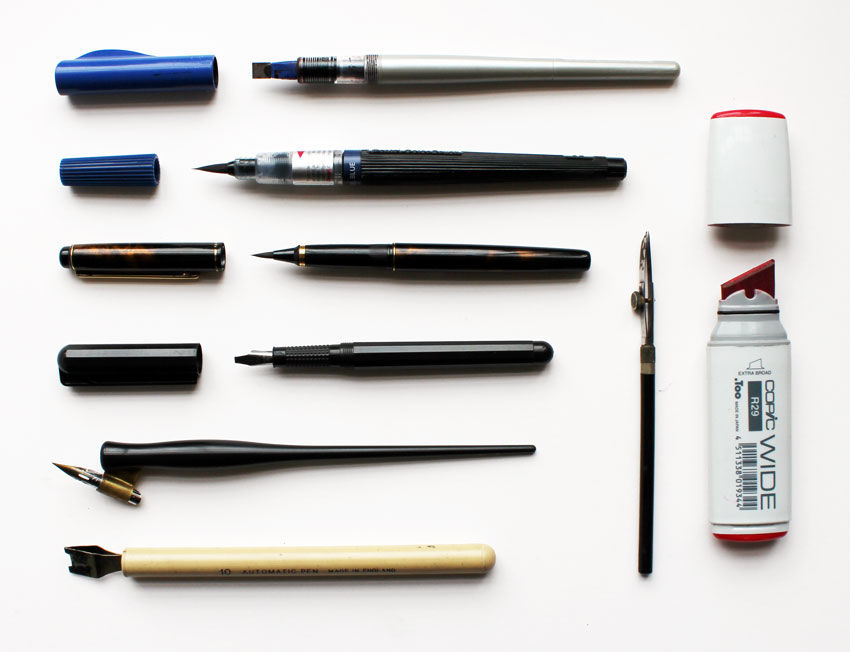How To Get Started In Calligraphy
- Seb Lester
- Dec 21, 2017
- 3 min read
Updated: Dec 8, 2023
Many hundreds of people have been asking me questions recently about what pens I use and how to get started in Calligraphy. This seems like the perfect time and place to help promote the practice and appreciation of this beautiful, ancient art form. Calligraphy has been created with various tools over the past 2,000 years or so in the West.
Regarding broad-edge tools necessary for Gothic and Italic styles of calligraphy, Pilot Parallel Pens are good tools for beginners. These are the pens I have been using for the clips that have recently gone viral on social media and websites like Design Taxi and BuzzFeed. ‘Manuscript’ brand calligraphy fountain pens are widely available and practical beginner tools. As you advance, you will probably want to use traditional metal calligraphy nibs made by established manufacturers like Brause and Mitchell and Automatic Pens. They can be a bit more difficult to handle, but you can help achieve finer, crisper results.
I recommend trying Nikko G nibs for pointed pen calligraphy, which is characterised by graceful curves and strong contrasts in line width. You can use these in either a traditional or an oblique pen holder; it is a matter of personal preference. Iron Gall ink is best for this type of calligraphy. Walker’s Copperplate Ink and McCaffrey’s Ink get great results for me.
Paper is always an important consideration. I often use Daler Rowney Smooth Cartridge Paper with Pilot Parallel Pens, but any smooth cartridge paper should be fine. When working on roughs for any type of calligraphy, I often use layout paper and marker pads. In terms of sketch pads a lot of calligraphers like the Rhodia and Claire Fontaine brands as the paper doesn’t bleed easily. As with everything the key is to experiment, paper with more texture can produce interesting results too.
Regarding books for inspiration, I can recommend ‘Scribe: Artist of the Written Word’ by John Stevens, a true modern master. For instruction, I would also suggest ‘Foundations of Calligraphy’ by the brilliant Sheila Waters. Calligraphy by Gaye Godfrey-Nicholls was published last year. It is a good book for beginners. Any of ‘The Speedball Textbook’ series is also an inexpensive source of instruction and inspiration.
The key to producing beautiful calligraphy is perseverance. Progress comes through focused and sustained study and practice. You will only persevere if you enjoy what you’re doing. For this reason, I’d personally suggest starting with a calligraphy style you particularly like the look of. When you reasonably grasp that style, you will notice that many of the skills are transferable to other styles.
I feel so lucky to have found what Hermann Zapf described as “this peaceful and noble art”. My working process as a designer and artist has evolved into a hybrid style blending my knowledge of both traditional and digital tools. There are some things computers can't do and vice versa. I think this is a great way to work. I have a broader palette of tools to choose from, which I find beneficial. I feel I am becoming a better artist and designer every day, which makes me very happy.
So, if you want to try calligraphy, just have fun. Don’t be discouraged by early failures; there will be many of those. However, with lots of personal experience, I can say that success is built on failure.
Some recommended tools are below. These tools reflect my taste and are not a definitive list. Other calligraphers would most likely recommend other tools. From top to bottom: Pilot Parallel Pen, Pentel Colour Brush, Kuretake No. 13 Fountain Brush Pen, Manuscript Italic Fountain Pen, Nikko G Nib with oblique pen holder, Automatic Pen, Copic Wide Marker, Ruling Pen.

This article was written in March 2015.




